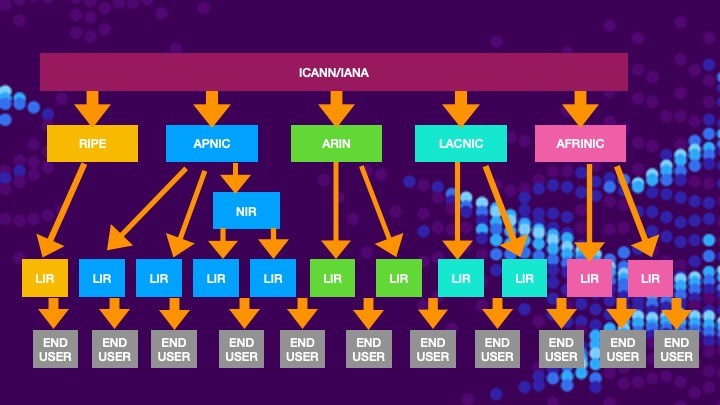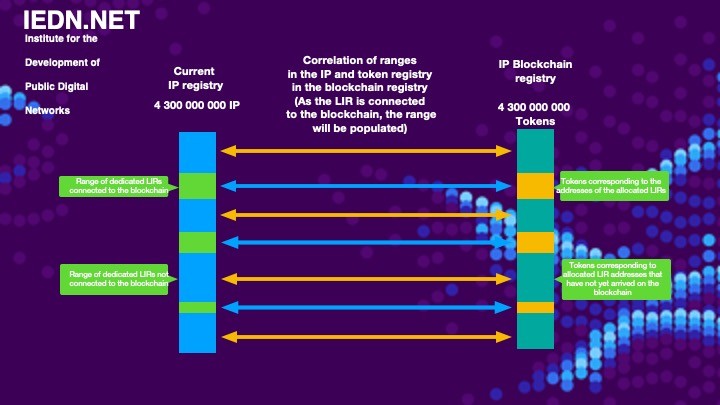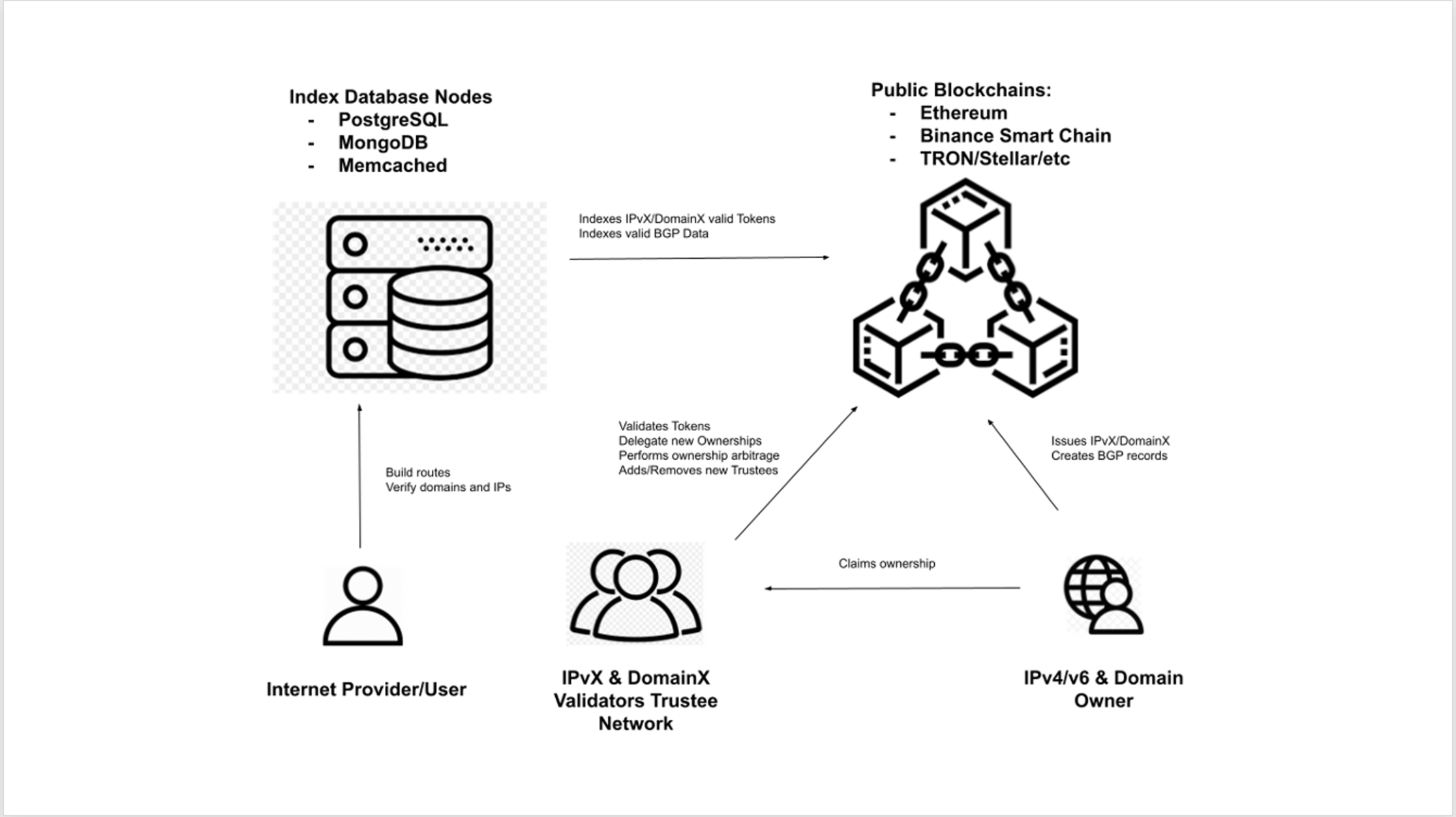Background
The resources discussed here include IPv4 and IPv6 addresses, autonomous systems, and data protocols.
Currently there is a registry of IPv4 addresses that contains 4.3 billion entries, each of which is a 32 bit number written as a binary code, for example 255.255.255.255. This is called an IPv4 address. This protocol is currently the most common protocol on the Internet.
Besides this protocol there’s less widespread but gradually developing protocol IPv6 which is a register of addresses in 128 bit format and contains more than 5×10^28 addresses.
Currently, all numbered resources are distributed centrally through ICANN [1] and its regional resellers RIRs [2], which in turn distribute resources through local registries (LIRs) [3] to end-users. The domain name system functions in a similar manner. (Picture 1)
This mechanism is largely a historical one, as the primary allocation was from one point, from one registrar. The modern system of maintaining registries of numbered Internet resources, involves a clear hierarchy in which the distribution takes place from the IANA [4] to the end user.
Such centralization of the management of the number resource register places natural limitations on the prospects for the development of the Internet as a
dynamic and flexible system, as a large number of decision makers intervene in the distribution process and attempt to bureaucratically regulate the allocation and management of Internet resources.

Picture 1. The allocation structure
The current arrangement provides clear preconditions for the fragmentation and sovereignisation of the Internet, with the consequent isolation of users from the global world network and individual information flows. National registries have already emerged in a number of Regional structures and sovereign registries are being tested in some countries.
The whole structure, from our point of view, needs to be reviewed in the direction of decentralization and democratization.
Basic Concept
In this article we will consider the possibility of creating a distributed registry of Internet resources based on NFT [5] blockchain technology. The data structure of such a registry will be identical to the existing registries of number resources of IP addresses, but will have all the advantages that blockchain provides. In the future, this registry could be extended to autonomous systems, routing tables, and domain names.

Picture 2. The process of creating and populating a blockchain register corresponding to the existing IPv4 registry (Developed by IEDN)
The basic idea is to transform an IPv4-based registry into a blockchain-based registry. To do this, it is proposed to create 4.3 billion entries in the form of NFT tokens, each corresponding to one IP address of the IPv4 protocol. In this way, we will create a new blockchain protocol IPvX. (Picture 2)
The following model is proposed for the dissemination of this technology. Each local registry can receive, according to the range of IP addresses they have under management, a similar number of tokens in the blockchain corresponding to the addresses the registry has.
The use of tokens will allow for activities such as sale, lease, temporary transfer of rights, etc. Tokens corresponding to IP addresses will validate ownership of the IP address and allow transactions not available to the current LIR owner. This is achieved by a blockchain registry, where the rules allowing for flexibility are set by its developer, not by the organisation managing the IP address space. In order to transfer ranges or create different objects such as inetnum, rout, etc., the token holders will have to combine their efforts to assemble a group of tokens that constitute the minimum range /24 to allow the creation and action on the object. The tokens held by the end users confirm their ownership of the corresponding IP address, a registry of which is maintained by the local registry. The transfer of ownership can be described in the form of a smart contract. Also, all other activities with IP address tokens can be described as smart contracts whose validity is confirmed by a blockchain arbitrator. The arbitrators in this design could be just the LIRs acting as registry managers within the range of IP addresses available to them. (Picture 3)

Picture 3. IP address tokenisation model via an internet platform (Developed by IEDN)
Benefits of a blockchain register
Here are the obvious benefits arising from moving to a blockchain-based registry:
1. Decentralisation. Blockchain enables decentralised storage and processing by distributing information about the state of the IP registry to all participants. As long as at least one computer is running, the information about the state of the registry is alive. With the current design, the registry is only maintained by ICANN and RIR servers, which is clearly not enough for the system to be considered decentralised. Blockchain is a public database with no centralized management, i.e. there is no administrator who can change entries under the superadmin’s password at will, most community members must agree to make changes.
2) Security. The existing system is not protected from unscrupulous users, unlike blockchain system based on encryption and mathematical calculations and does not depend on subjective actions of a user. Blockchain is not just a distributed database, it is first and foremost a distributed supercomputer. Smart contracts once created in the network are no longer subject to change (unless a new version of the contract is released) and work without human intervention
3. Transparency and Anonymity. All IP management rights are visible to all participants while respecting the principle of anonymity.
4. Trustworthiness. Information cannot be corrected, tampered with or deleted due to the fact that it is controlled by a huge number of devices. One of the basic principles of blockchain technology is Zero Trust, no one is a trustee with rights until a key has been submitted and the blockchain signature chain has been verified by multiple validators.
5.Self-sufficiency. There is no centralised management, no need for intermediaries like RIR, IANA and other elements of the existing hierarchical system of management and resource allocation, you can abandon rudiments like Legacy and PI resources.
6. Resource saving. Rational use of IP resources for specific needs and prevention of wasteful practices of their accumulation by individual entities.
In blockchain, everyone can get the required amount of resources, and the introduction of payment for each transaction will serve as a mechanism to curb hoarding.
7. Sharing. IP address transactions can come down to one specific IP address. The current registry only allows this to be done with groups of addresses, nets /24 of 256 addresses.
Technical Solution
General description
The IP registry stores information about the permanent and temporary owners of IP addresses. A public blockchain is used for transparent storage and access control. (Picture 4)
Each IP address or subnet is an IPvX non-fungible token.
This token is backwards compatible with the standard ERC721 token, allowing these tokens to be traded on any open NFT platform.

Picture 4. Schematic of the technical implementation of the project – IP Address (IPv4 / IPv6) Registry – IPvX-NF-Token (Developed by IEDN)
The token code for the Ethereum network is available at:
https://github.com/genosse/ipvx-nf-token
Each̆ token can change ownership and disintegrate into child tokens when subnets̆ are split.
IPvX Validators Trustee Network
The function of this subsystem is to validate the original IP address owners.
It is also a smart contract in the Ethereum network.
It solves two tasks:
1. Validation of issued IPvX-NF-Token.
2. Arbitrage of disputes on IP ownership.
All algorithms are written in smart contract:
Validation of tokens (IPvX, DomainX) is decided by simple majority of participants. Acceptance and exclusion of members in Trustee Network is also decided by simple majority.
Valid IPvX-NF-Token Index Database
This database stores IPvX-NF-Token indexes and their validation flags on the IPvX-Trustee network and provides a fast API for obtaining information about valid IPvX-Trustee subnets and individual IP (IPv4, IPv6) owners/tenants.
Technically it is an open-sourcĕ code for a PostgreSQL database and a REST API to it̆. Anyonĕ who wishes tŏ raise a full or trimmed node to store such indexes. This is implemented by validation sites such as InterLIR and the like.
The Domain Name Registry / Database is created similarly to IP addresses, DomainX-NF-Token
https://github.com/genosse/domainx-nf-token
BGP Table Decentralized Registry / Database
One of the most important technical tasks is the development of technology for the transfer to blockchain routing tables. That is, to implement the ability to create BGP routes between autonomous systems and write them as smart contracts, which will also enable the transfer of financial calculations for data transfer within the blockchain between its users. Only a verified̆ owner has the ability to create a valid route. Fast database with smart contract verification based on PostgreSQL/MongoDB/Memcached
One of the challenges is that it will be necessary to come up with a system to store the routers. A fast database to store BGP and a public̆ blockchain to validate them based on an IPvX-NF-Token
Expected results
What will it achieve? Firstly, a number of restrictions on IP transfers between owners are removed, and secondly, a legal framework is created for a wide variety of transactions in the form of smart contracts with IP addresses. Thirdly, when users reach a fill rate of more than 50% of the NFT token blockchain register corresponding to the same number of IPs in the current registry, the question arises, which registry is the true one? And there is a real possibility that users of the IP address space will switch to the blockchain registry as being more convenient and promising. If one prepares the additional features associated with the porting of BGP routing and ASN registry processes to this blockchain, together this will become a new internet registry for all existing users.
The attraction of this model lies in the ease with which resources themselves can be monetized in the form of NFT tokens and transactions in the form of smart contracts.
If we talk about monetization of this process, currently the cost of one IP address on the market is about 50 euros, and this with substantial restrictions on their transfer (two-year moratorium on the next transfer between local registrars after each transfer) and also with impossibility to share IP blocks for transfer less than /24, which corresponds to 256 addresses.
Even so, the global IP address market for IPv4 alone has a capacity of about 200 billion euros.
[1]. The Internet Corporation for Assigned Names and Numbers coordinates the allocation of unique names and addresses on the internet. This includes the coordination of the Domain Name System and the allocation of IP addresses, which is also referred to as the “IANA function”.
[2]. A Regional Internet Registry (RIR) is a regional organisation entrusted with the administration and allocation of internet resources. The responsibility includes the administration of IP addresses (IPv4 and IPv6) as well as AS numbers.
[3]. A Local Internet Registry (LIR) is an organisation which has been allocated one or more blocks of public IP addresses or AS numbers by a Regional Internet Registry (RIR) and which uses them to serve mostly its end customers. Most LIRs are Internet service providers, companies or academic institutions that either use the IP address blocks allocated by the RIR themselves and/or allocate them to third parties. Membership in an RIR is a prerequisite for becoming an LIR.
[4]. The Internet Assigned Numbers Authority is a division of ICANN and is responsible for assigning numbers and names on the internet, especially IP addresses. It is one of the oldest institutions on the internet.
[5]. A Non-Fungible Token is a “cryptographically unique, indivisible, irreplaceable and verifiable token that represents a specific item, whether digital or physical, in a blockchain”.
Alexey Shkittin (IEDN)